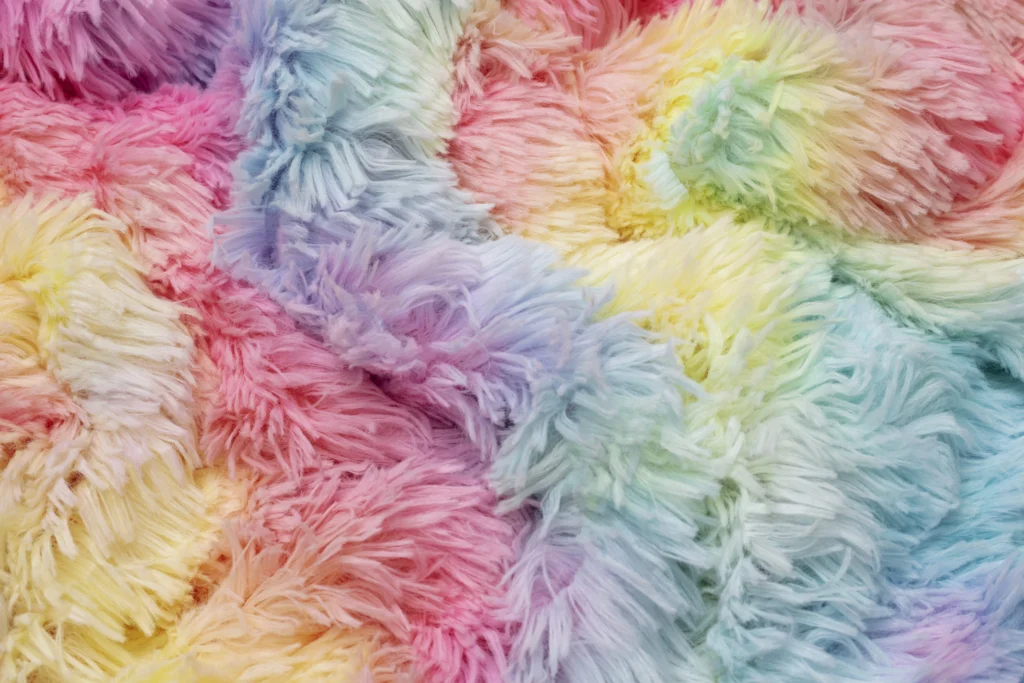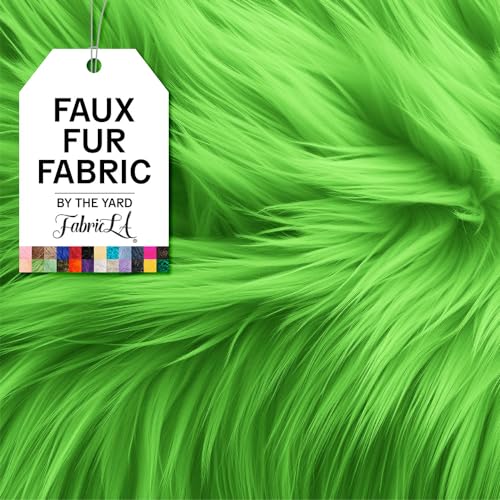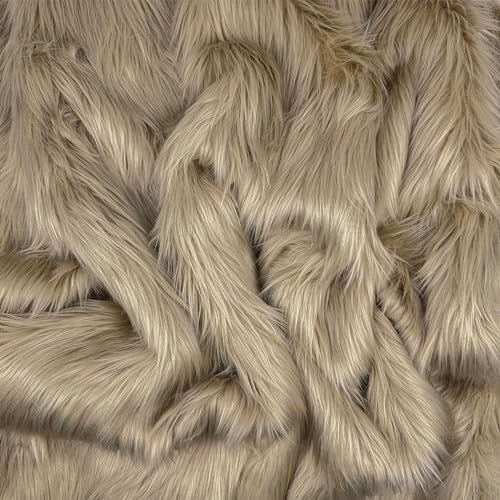
Fuzzy and plush fabrics are versatile and popular in a wide range of creative projects. With their soft, fluffy texture, these fabrics can bring a warm and cozy touch to home decor, crafts, costumes, and more.
Here we will explain the different types of fuzzy fabrics, their common uses, and how to choose the best one for your projects.
Types of Fuzzy Fabrics: Plush, Faux Fur & More
The term “fur fabrics” covers a variety of fabrics that are characterized by their soft, plush surface. Each type of fabric has specific characteristics that make it suitable for different applications.
1. Plush
Terry is a popular fabric distinguished by its fluffy and thick texture. This type of fabric is commonly used in winter clothing, such as robes and pajamas, due to its ability to retain heat. It is also perfect as upholstery fabric and craft fabric, thanks to its durability and comfort.
2. Synthetic Plush
Faux fur is one of the most popular options for craft and home decor projects. This fluffy fabric is made from synthetic fibers such as polyester, making it durable and easy to clean. It is ideal for creating toys, cushions, and blankets.
3. High Quality Plush Fabrics
Plush fabrics can vary in thickness and quality, from lightweight options to denser fabrics that resemble wool. These fabrics are perfect as lining fabric for garments and blankets, providing a comfortable and luxurious feel.
4. Winter fabrics
Fuzzy fabrics are also associated with fabrics designed specifically for winter. The plush texture of these fabrics helps to retain heat and offers effective insulation. They are very popular in outerwear, such as lined jackets and scarves.
Popular uses of fuzzy fabrics
Plush fabrics and other similar fabrics are used in a wide variety of projects, both functional and decorative.
1. Home Decoration
Fuzzy fabrics are an excellent choice for furnishing fabric. They can be used to cover cushions, blankets and curtains, providing a cosy touch to any space. The soft, fluffy texture adds an element of warmth that transforms the atmosphere of a room.
2. Upholstery
Using upholstery fabric with a shag or plush finish can give a facelift to furniture such as sofas and chairs. These fabrics not only offer comfort but also add a sleek and modern style. Upholstery fabric on plush upholstered furniture provides a touch of luxury and resistance to wear and tear.
3. Crafts and Creative Projects
Craft enthusiasts find plush fabrics an endless source of inspiration. This fluffy fabric can be used to create costumes, dolls, and other artistic projects. Plush fabric is also popular in the design of custom clothing and fashion accessories.
4. Winter Clothes
As a winter fabric, fuzzy fabrics are used to make coats, scarves, and hats. Their ability to keep you warm without sacrificing comfort makes them a popular choice for the cold season.
How to choose the perfect plush or furry fabric?
Choosing the right fabric depends on several factors, including the purpose of the project and the budget. Here are some key aspects to consider:
1. Fiber Type
The choice between natural and synthetic fibers is important. Synthetic plush fabrics, such as those made from polyester, tend to be more durable and affordable, while those made from natural fibers can offer greater breathability and softness.
2. Thickness and Texture
For upholstery projects or winter clothing, it is advisable to choose fabrics with an appropriate thickness that offer durability and insulation. For crafts or light decorating, a thinner plush may suffice.
3. Ease of Care
The ability to wash and keep the fabric soft and fluffy is essential, especially in projects that will be in frequent contact with people or pets. Faux plush fabrics are typically easier to clean and maintain than natural options.
Care and maintenance of plush fabrics
Fuzzy fabrics, while beautiful and functional, do require some care to maintain their appearance and softness. Here are some tips to extend the life of your plush and stuffed fabrics:
1. Regular Cleaning
It is important to vacuum plush fabrics to remove dust and debris. This is especially relevant for upholstery fabrics, which can accumulate dirt over time.
2. Proper Washing
To keep the fabric fluffy and prevent it from becoming misshapen, it is best to wash them by hand or on a gentle cycle in the washing machine with cold water. Use mild detergents and avoid using harsh fabric softeners that can damage the fibers.
3. Drying and Storage
Air drying is the safest option to maintain the fabric’s plush texture. If you use a dryer, use a low-heat cycle to prevent shrinkage.
This article shows you everything you need to know about fuzzy and plush fabrics, their uses and care. From decor and upholstery to craft projects and winter clothing, these fabrics offer a unique combination of aesthetics and functionality that you can make the most of.
Where to Buy Fuzzy and Plush Fabrics
See more fabrics
![kullaloo Wool White Faux Fur Fabric [3/4 inch Pile, 20 mm] | Shaggy Plush Minky Fabric for Sewing | 39.5x29.5 (More Fabric Than Half Yard) | Ideal for Plushies, Crafts, Costumes, Upholstery | Ivory](https://m.media-amazon.com/images/I/41pAHIw8ndL.jpg)


![kullaloo Shaggy Faux Fur Fabric [3/4 inch Pile, 20 mm] | Plush Minky Fabric for Sewing | 39.5x29.5 (More Fabric Than Half Yard) | Ideal for Plushies, Crafts, Costumes, Upholstery | Beige/Latte](https://m.media-amazon.com/images/I/51y6WdEvypL.jpg)

